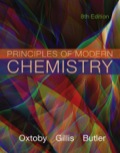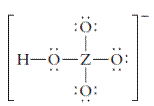
Concept explainers
a)
Interpretation:
The group should be determined to which Z belongs in the following Lewis structure and along with an example of such a compound or ion which actually exists.

Concept Introduction:
Number of lone pair and bond pair electrons on an atom can give the number of valence electrons. This is indicated by the group number of an atom.
Group number is equal to the valence shell electrons of an atom or electrons present in the outermost shell. Valence shell electrons of the atom take part in the bonding.
Formal charge on an atom is defined as the charge assigned to the atom in a molecule. It is assigned to an atom or molecule by assuming that the electrons in
Formal charge is equal to
b)
Interpretation:
The group should be determined to which Z belongs in the following Lewis structure and along with an example of such a compound or ion which actually exists.

Concept Introduction:
Number of lone pair and bond pair electrons on an atom can give the number of valence electrons. This is indicated by the group number of an atom.
Group number is equal to the valence shell electrons of an atom or electrons present in the outermost shell. Valence shell electrons of the atom take part in the bonding.
Formal charge on an atom is defined as the charge assigned to the atom in a molecule. It is assigned to an atom or molecule by assuming that the electrons in chemical bonds are shared equally between atoms, apart from relative electronegativity.
Formal charge is equal to
c)
Interpretation:
The group should be determined to which Z belongs in the following Lewis structure and along with an example of such a compound or ion which actually exists.

Concept Introduction:
Number of lone pair and bond pair electrons on an atom can give the number of valence electrons. This is indicated by the group number of an atom.
Group number is equal to the valence shell electrons of an atom or electrons present in the outermost shell. Valence shell electrons of the atom take part in the bonding.
Formal charge on an atom is defined as the charge assigned to the atom in a molecule. It is assigned to an atom or molecule by assuming that the electrons in chemical bonds are shared equally between atoms, apart from relative electronegativity.
Formal charge is equal to
d)
Interpretation:
The group should be determined to which Z belongs in the following Lewis structure and along with an example of such a compound or ion which actually exists.

Concept Introduction:
Number of lone pair and bond pair electrons on an atom can give the number of valence electrons. This is indicated by the group number of an atom.
Group number is equal to the valence shell electrons of an atom or electrons present in the outermost shell. Valence shell electrons of the atom take part in the bonding.
Formal charge on an atom is defined as the charge assigned to the atom in a molecule. It is assigned to an atom or molecule by assuming that the electrons in chemical bonds are shared equally between atoms, apart from relative electronegativity.
Formal charge is equal to
Want to see the full answer?
Check out a sample textbook solution
Chapter 3 Solutions
EBK PRINCIPLES OF MODERN CHEMISTRY
- For each reaction below, decide if the first stable organic product that forms in solution will create a new CC bond, and check the appropriate box. Next, for each reaction to which you answered "Yes" to in the table, draw this product in the drawing area below. Note for advanced students: for this problem, don't worry if you think this product will continue to react under the current conditions - just focus on the first stable product you expect to form in solution. དྲ。 ✗MgBr ? O CI Will the first product that forms in this reaction create a new C-C bond? Yes No • ? Will the first product that forms in this reaction create a new CC bond? Yes No × : ☐ Xarrow_forwardPredict the major products of this organic reaction: OH NaBH4 H ? CH3OH Note: be sure you use dash and wedge bonds when necessary, for example to distinguish between major products with different stereochemistry. Click and drag to start drawing a structure. ☐ : Sarrow_forwardPredict the major products of this organic reaction: 1. LIAIHA 2. H₂O ? Note: be sure you use dash and wedge bonds when necessary, for example to distinguish between major products with different stereochemistry. Click and drag to start drawing a structure. X : ☐arrow_forward
- For each reaction below, decide if the first stable organic product that forms in solution will create a new C - C bond, and check the appropriate box. Next, for each reaction to which you answered "Yes" to in the table, draw this product in the drawing area below. Note for advanced students: for this problem, don't worry if you think this product will continue to react under the current conditions - just focus on the first stable product you expect to form in solution. NH2 tu ? ? OH Will the first product that forms in this reaction create a new CC bond? Yes No Will the first product that forms in this reaction create a new CC bond? Yes No C $ ©arrow_forwardAs the lead product manager at OrganometALEKS Industries, you are trying to decide if the following reaction will make a molecule with a new C-C bond as its major product: 1. MgCl ? 2. H₂O* If this reaction will work, draw the major organic product or products you would expect in the drawing area below. If there's more than one major product, you can draw them in any arrangement you like. Be sure you use wedge and dash bonds if necessary, for example to distinguish between major products with different stereochemistry. If the major products of this reaction won't have a new CC bond, just check the box under the drawing area and leave it blank. Click and drag to start drawing a structure. This reaction will not make a product with a new CC bond. G marrow_forwardIncluding activity coefficients, find [Hg22+] in saturated Hg2Br2 in 0.00100 M NH4 Ksp Hg2Br2 = 5.6×10-23.arrow_forward
- give example for the following(by equation) a. Converting a water insoluble compound to a soluble one. b. Diazotization reaction form diazonium salt c. coupling reaction of a diazonium salt d. indacator properties of MO e. Diazotization ( diazonium salt of bromobenzene)arrow_forward2-Propanone and ethyllithium are mixed and subsequently acid hydrolyzed. Draw and name the structures of the products.arrow_forward(Methanesulfinyl)methane is reacted with NaH, and then with acetophenone. Draw and name the structures of the products.arrow_forward
- 3-Oxo-butanenitrile and (E)-2-butenal are mixed with sodium ethoxide in ethanol. Draw and name the structures of the products.arrow_forwardWhat is the reason of the following(use equations if possible) a.) In MO preperation through diazotization: Addition of sodium nitrite in acidfied solution in order to form diazonium salt b.) in MO experiment: addition of sodium hydroxide solution in the last step to isolate the product MO. What is the color of MO at low pH c.) In MO experiment: addition of sodium hydroxide solution in the last step to isolate the product MO. What is the color of MO at pH 4.5 d.) Avoiding not cooling down the reaction mixture when preparing the diazonium salt e.) Cbvcarrow_forwardA 0.552-g sample of an unknown acid was dissolved in water to a total volume of 20.0 mL. This sample was titrated with 0.1103 M KOH. The equivalence point occurred at 29.42 mL base added. The pH of the solution at 10.0 mL base added was 3.72. Determine the molar mass of the acid. Determine the Ka of the acid.arrow_forward
 Principles of Modern ChemistryChemistryISBN:9781305079113Author:David W. Oxtoby, H. Pat Gillis, Laurie J. ButlerPublisher:Cengage Learning
Principles of Modern ChemistryChemistryISBN:9781305079113Author:David W. Oxtoby, H. Pat Gillis, Laurie J. ButlerPublisher:Cengage Learning Chemistry for Today: General, Organic, and Bioche...ChemistryISBN:9781305960060Author:Spencer L. Seager, Michael R. Slabaugh, Maren S. HansenPublisher:Cengage Learning
Chemistry for Today: General, Organic, and Bioche...ChemistryISBN:9781305960060Author:Spencer L. Seager, Michael R. Slabaugh, Maren S. HansenPublisher:Cengage Learning World of Chemistry, 3rd editionChemistryISBN:9781133109655Author:Steven S. Zumdahl, Susan L. Zumdahl, Donald J. DeCostePublisher:Brooks / Cole / Cengage Learning
World of Chemistry, 3rd editionChemistryISBN:9781133109655Author:Steven S. Zumdahl, Susan L. Zumdahl, Donald J. DeCostePublisher:Brooks / Cole / Cengage Learning Chemistry: Principles and PracticeChemistryISBN:9780534420123Author:Daniel L. Reger, Scott R. Goode, David W. Ball, Edward MercerPublisher:Cengage Learning
Chemistry: Principles and PracticeChemistryISBN:9780534420123Author:Daniel L. Reger, Scott R. Goode, David W. Ball, Edward MercerPublisher:Cengage Learning Living By Chemistry: First Edition TextbookChemistryISBN:9781559539418Author:Angelica StacyPublisher:MAC HIGHER
Living By Chemistry: First Edition TextbookChemistryISBN:9781559539418Author:Angelica StacyPublisher:MAC HIGHER





